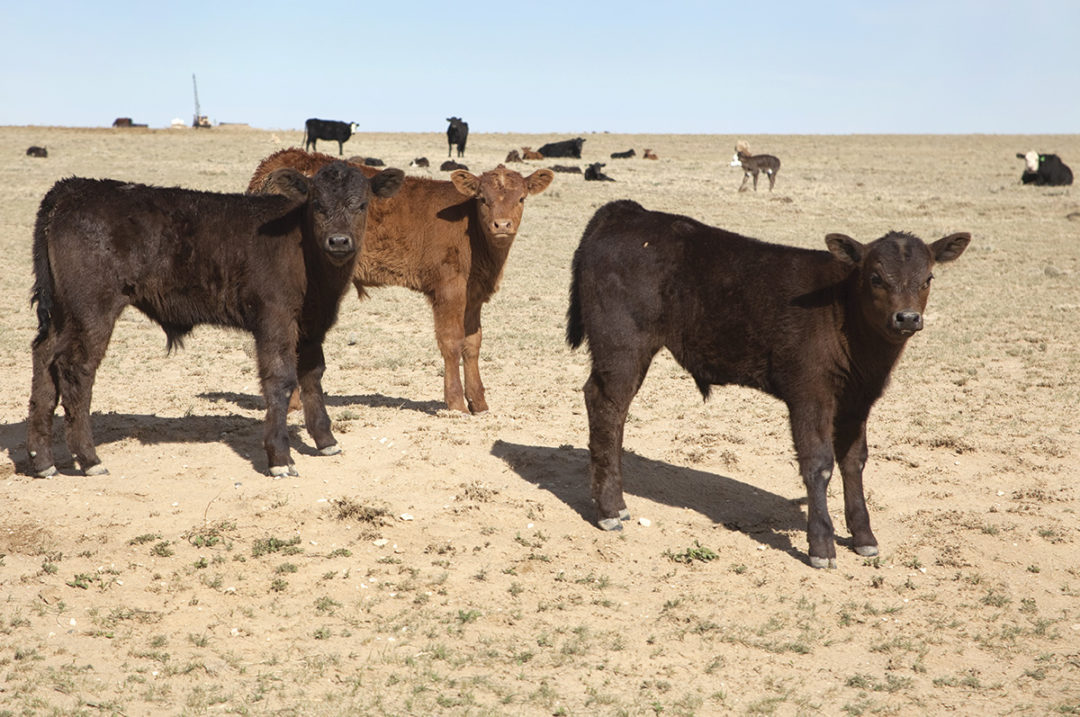The calls I typically get in the fall about forage options have started early this year. With drought persisting through much of the U.S., many producers are already seeing stunted growth in first and second hay cuttings on dryland. Here are some things we need to consider as we manage our forages through these challenging times.
First, as we continue grazing season in this drought, we should be mindful of prussic acid. Prussic acid is also known as hydrogen cyanide (HCN). The compound is present in the leaves of the plants in a compound called dhurrin. Under normal conditions, plant membranes separate dhurrin from the enzyme responsible for hydrolyzing HCN from dhurrin. Ruminants such as cattle, sheep and goats are more susceptible to prussic acid poisoning due to the chewing of their cud. As these animals ruminate, plant cell membranes are damaged allowing the enzyme access to dhurrin, thereby releasing HCN into the rumen. HCN is then absorbed directly into the bloodstream where it binds hemoglobin. The bound hemoglobin cannot transfer oxygen to individual cells, and death by asphyxiation is the result.
Drought stress increases the chances of unbound HCN accumulation in plant tissue. There have already been reports of livestock losses due to prussic acid in this year’s drought. Forages that typically accumulate prussic acid are sorghum-sudan species and johnsongrasses. These forages should be analyzed prior to letting livestock out to graze. Be sure to contact the lab before submitting the sample, as this analysis has specific submission procedures because it is a gas that can easily escape the plant in shipping if improperly submitted.
Next, nitrates should be top of mind. When cattle consume high-nitrate feeds, the microbes in the rumen convert that nitrate to nitrite. The nitrite is then in the gas, which the cattle belch and then inhale. The nitrite then binds to the blood hemoglobin, preventing oxygen from binding. At levels between 1,400 – 2,100 parts per million (PPM), nitrate nitrogen (NO3-N) can cause spontaneous abortions with no warning signs or symptoms.
As a reviewer at a commercial lab, I have already seen extremely high nitrate samples in common nitrate-accumulating species. Just yesterday, I reviewed a sample of sorghum at 10,800 ppm NO3-N. That is more than double our recommended cutoff for allowing animal consumption even with the ability to thoroughly mix the forage into a ration (5,000 ppm NO3-N). The producer explained that the field was stressed with plants of all different heights across the field.
So what can forage producers do to avoid this situation?
Test our standing forages and see what adjustments can still be made. Submitting a sample for nitrate analysis prior to cutting for hay can allow producers to change their cutting heights or ensile if necessary. I recommend producers sample their standing forage at the height they plan to cut. Then, if nitrate results are marginal, they have the option to raise the cutting height. The trade-off to raising the cutting height is sacrificing yield.
Or, if the nitrate results are high, ensiling may be an option to reduce nitrates and still make use of the forage. It is key to be realistic with ensiling expectations. While it can reduce nitrates by up to half, there is no guarantee. So plan on about a 20% reduction when making these forage management decisions.
In addition to raising the cutting height or ensiling, some producers may opt to allow the forage to continue growing and try to get it to convert some of those nitrates into protein. Unfortunately, when this strategy is implemented, forage quality is sacrificed. As forages mature, they become more fibrous and less digestible for our livestock species.
Further, along with producers submitting common nitrate-accumulating species, in extremely drought-stressed areas, some producers may be wise to test legume hays as well. While rare, during drought events, I have reviewed some alfalfa hay samples grown on dryland that were high in nitrate. I typically do not recommend producers check alfalfa for nitrates. However, if your plant is showing signs of stress and grew under very dry conditions, it may be a diligent request.
As we continue forward through this challenging year, I hope producers can use these strategies to ensure their forage is safe for livestock consumption. ![]()











